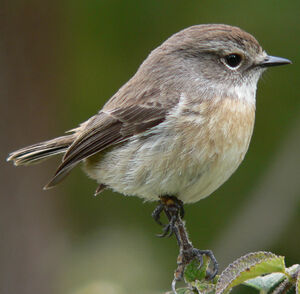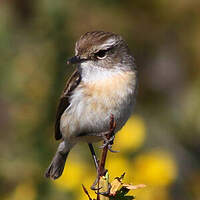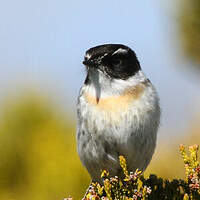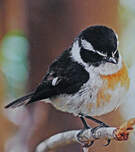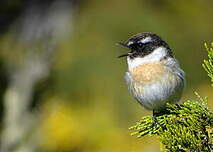Reunion Stonechat
Saxicola tectes - Tarier de la Réunion
Identification
The Reunion Stonechat is a small, round-bodied, high-legged bird. It is one of the smallest stonechats. Like almost all birds of the Saxicola genus, the male has blackish head, back and wings with some brownish reflections. Depending on the individual, it has a more or less pronounced white eyebrow sometimes going up to the base of the beak. For some males, the head is entirely black. The throat and neck are white. A white bar also starts from the shoulder and goes down to the under-tail feathers, also more or less prominent. A conspicuous red spot on the chest can extend to the abdomen. The rectrices are totally black, as are the legs and beak. All these colour variants are due to the polymorphism that the males have. Some of them are almost indistinguishable from the females.
The female has the same characteristics as the male but much more dull. Head, back and wings light brown to gray. The white eyebrow is also less marked. The throat and neck are white. The chest and belly are pale chamois white.
For both sexes, the iris is brown.
The juvenile resembles the female with pale brown streaks on the chest, back and head.
Subspecific information monotypic species
Foreign names
- Tarier de la Réunion,
- Tarabilla de Reunión,
- cartaxo-da-reunião,
- Réunionschmätzer,
- réunioni csuk,
- Réunionroodborsttapuit,
- Saltimpalo di Reunion,
- réunionbuskskvätta,
- Reunionsvartstrupe,
- pŕhľaviar réunionský,
- bramborníček réunionský,
- Réunionbynkefugl,
- reunionintasku,
- bitxac de l'illa de la Reunió,
- kląskawka białogardła,
- Реюньонский чекан,
- レユニオンノビタキ,
- 留尼汪石䳭,
- réunionbuskskvätta,
- 群聚石鵖,
Voice song and call
Habitat
The Reunion Stonechat can be found almost everywhere on the island of Reunion. Its preferred habitat is between 600 and a little over 2,800 meters above sea level. However, it can be seen on the wild trails of the south at sea level. It frequents the edges of moist or dry forests, open environments such as agricultural plains, as well as environments degraded by ancient lava flows and resembling maquis today.
Behaviour character trait
The Reunion Stonechat is a solitary bird but so common that it is frequent to encounter one every two or three meters.
Males and females have the same posture: round, wings hanging and tail raised, often on one leg. The Reunion Stonechat perches on a lookout at an height that does not exceed human size. Encounters with this curious little bird can multiple all the more. On a branch, fence or near the ground on a small rock, it inspects the ground looking for insects. Very interested in what the hikers raise with their shoes, it can easily follow them some minutes or even come to meet them. Not shy at all, it can sometimes go unnoticed and be discovered only when it flies away in front of their eyes.The male sings with its tail raised, rectrices separated and wings trembling. The song is both done when perched and when flying.
To parade, the male sings flying very quickly vertically, which can be quite complicated at high altitudes in days of strong winds.
Dietfeeding habits
Reproduction nesting
Threats - protection
IUCN conservation status
concern
in the Wild
threatened
evaluated
The Reunion Stonechat is protected by a ministerial decree of 17 February 1989. Its population is stable and little threatened thanks to its ability to adapt to degraded environments.
Sources of information
- IOC World Bird List (v14.2), Gill, F and D Donsker (Eds). 2024-04-18.
- Société d'Etudes Ornithologiques de la Réunion ,
- Oiseaux des iles de l'océan Indien, Langrand Olivier, ian Sinclair
Other sources of interest
 Specification sheet created on
25/07/2023 by Nathalie Santa Maria
Specification sheet created on
25/07/2023 by Nathalie Santa MariaTranslation by AI Oiseaux.net
© 1996-2025 Oiseaux.net
- Accipitriformes
- Aegotheliformes
- Anseriformes
- Apodiformes
- Apterygiformes
- Bucerotiformes
- Caprimulgiformes
- Cariamiformes
- Casuariiformes
- Charadriiformes
- Ciconiiformes
- Coliiformes
- Columbiformes
- Coraciiformes
- Cuculiformes
- Eurypygiformes
- Falconiformes
- Galliformes
- Gaviiformes
- Gruiformes
- Leptosomiformes
- Mesitornithiformes
- Musophagiformes
- Nyctibiiformes
- Opisthocomiformes
- Otidiformes
- Passeriformes
- Pelecaniformes
- Phaethontiformes
- Phoenicopteriformes
- Piciformes
- Podargiformes
- Podicipediformes
- Procellariiformes
- Psittaciformes
- Pterocliformes
- Rheiformes
- Sphenisciformes
- Steatornithiformes
- Strigiformes
- Struthioniformes
- Suliformes
- Tinamiformes
- Trogoniformes

